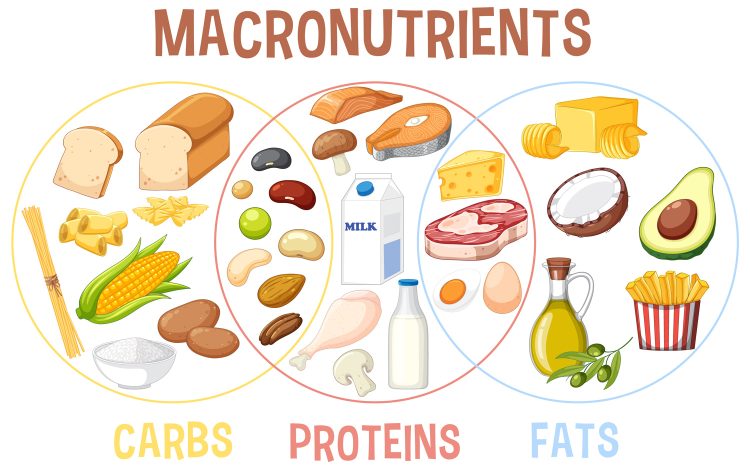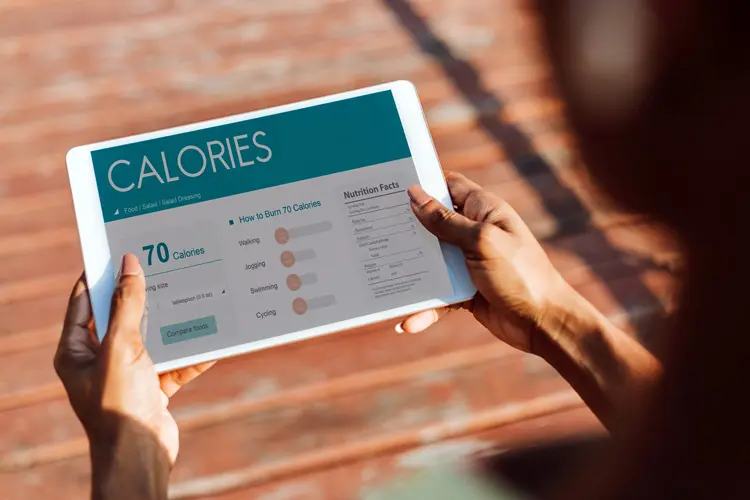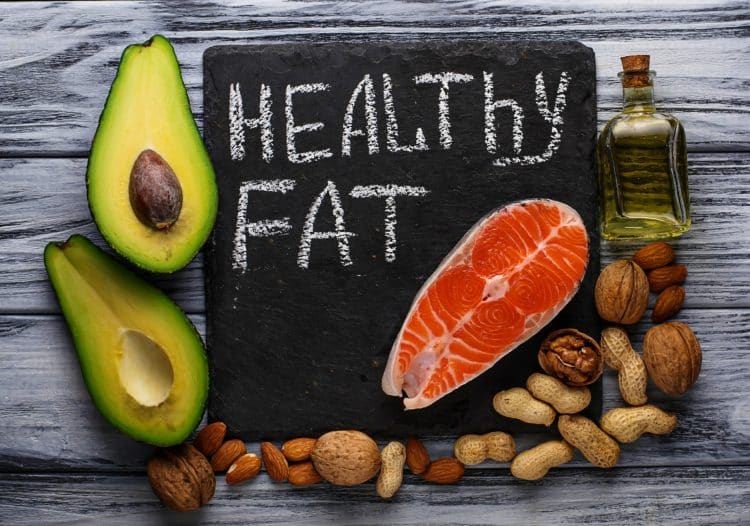As a veteran personal trainer, I can attest that managing your diet can be more challenging in a transformation program than working out. A workout can last between 30 minutes to two hours, depending on your training experience and objectives.
However, you spend the remaining 14 hours of your waking time outside the gym, assuming you sleep for eight hours a day. What you do (and eat) during this time will determine how quickly you reach your objectives.
While most people have heard of calories, far fewer understand the concept of macronutrients. This is why beginners usually have a simple daily calorie target.
Calorie counting involves tracking the total number of calories you consume in a day. Creating a calorie deficit (burning more calories than you consume) can lead to weight loss. A surplus (eating more than you burn) results in weight gain. Eating and burning the same amount of calories helps maintain your weight.
While calorie counting can be effective, I’ve seen firsthand that macro tracking is a much more effective diet strategy. It involves consuming a particular amount of protein, carbs, and fats daily to optimize body composition and boost performance and overall well-being.
Macro Tracking: Introduction
While calorie counting can be more convenient than macronutrient tracking, it doesn’t consider the quality of food choices or the impact of certain foods on your overall physique and body composition.
Level Up Your Fitness: Join our 💪 strong community in Fitness Volt Newsletter. Get daily inspiration, expert-backed workouts, nutrition tips, the latest in strength sports, and the support you need to reach your goals. Subscribe for free!
Tracking macros can prevent nutrient deficiencies, ensure a constant supply of energy throughout the day, promote satiety and metabolism, and improve overall function.
Macro tracking focuses on the three macronutrients:
- Protein: It is the building block of muscle and is required for recovery and satiety.
- Carbohydrates: Your body’s primary energy source. It is essential to fuel your high-intensity workouts.
- Fats: Healthy fats support hormone balance and other bodily functions.
Contrary to what most people think, you don’t need to starve yourself to lose weight. Strategically lowering your macro intake can help you cut weight without making you feel deprived and weak.
“Tracking your calorie intake, even for a short period of time, can be a very educational experience. It can help you to learn about portion sizes and how many calories different foods contain,” said Dr. Layne Norton (Ph.D. in Nutritional Sciences).
Macro tracking incentivizes prioritizing whole foods, which can optimize your energy levels and performance and ensure you’re getting all the ingredients you need to achieve your goal physique.
Why Macro Tracking Trumps Calorie Counting
Here are the reasons why you should opt for macro tracking over calorie counting:
Improved Nutrient Balance
When you’re solely focused on the calorie content of a food or a beverage, you are missing the bigger picture. You could hit your daily 2,000-calorie target by eating around 10 medium-sized donuts. However, that won’t do any good for your weight loss goals.
On the other hand, eating a balanced diet consisting of healthy carbs, proteins, and fats is a completely different story.
Tracking your macronutrient intake will ensure you get the right mix of protein, carbs, and fats to maximize performance and achieve your fitness goals.
The Satisfaction Factor
A calorie-tracking-based diet doesn’t distinguish between different food sources. However, eating highly processed foods can make you starve after a few hours of a meal, irrespective of the portion size.
Macro-based meals balance proteins and healthy fats, which can help you feel full for longer. It reduces the probability of binging on junk food throughout the day.
Metabolic Benefits
While macro tracking, you must tweak your nutrient intake based on your most important goals. For example, you will bump up your protein intake on a muscle-building program. A high-protein diet can boost metabolism and help burn calories even at rest.
Conversely, relying on whole-food carbs and healthy fats can help stabilize blood sugar levels and improve body composition.
When you are tracking macros, you are in complete control of your nutrition. Small changes in your nutrient intake can lead to significant results.
Getting Started with Macro Tracking
Now that you know the differences between calorie counting and macro tracking and understand the latter’s benefits, here is how to get started:
Calculate Your Daily Macro Goal
This is how to determine your target macros:
Understanding BMR
The Basal Metabolic Rate (BMR) is the number of calories your body requires to perform basic functions like breathing and digestion. It forms the foundation of your macro needs.
Online Macro Calculators
Although there are several formulas you can use to determine your ideal daily macro target, manual calculations can get overwhelming. Use our macronutrient calculator to get a personalized breakdown of the exact amount of protein, carbs, and fats you must eat in a day.
How To Choose the Right Macro Split
The precise amount of carbs, fats, and proteins you must consume will vary depending on your goals. Here is how to structure your macro split based on your goals:
- Weight Loss: Prioritize protein, eat a moderate amount of carbs, and restrict your fat intake.
- Building Muscle: Increase your protein and carb intake to boost recovery and ensure a constant energy supply. Eat a moderate amount of healthy fats for sustained energy release and hormone support.
- Maintenance: A 40:30:30 macro split is quite famous for the maintenance phase. It involves 40 percent carbs and 30 percent each of proteins and fats.
According to a randomized controlled trial published in the Journal of American Medical Association, the resting energy expenditure (REE) and total energy expenditure (TEE) were greatest with a low-fat diet, intermediate with a low-glycemic index diet, and least with a very low-carbohydrate diet. (1)
Level Up Your Fitness: Join our 💪 strong community in Fitness Volt Newsletter. Get daily inspiration, expert-backed workouts, nutrition tips, the latest in strength sports, and the support you need to reach your goals. Subscribe for free!
Macro Tracking Tools
“To get started with macro counting, you will need to download a macro tracking app and start logging your food intake,” said seven-time CrossFit Games athlete Kristi O’Connell. “It is important to track your food intake for at least 7-10 days to get a baseline of how much you are currently eating.”
I recommend my clients use the MyFitnessPal app to track their calorie intake as it has a huge database and logging foods is as easy as scanning a barcode. It provides a detailed macro breakdown, which can help make healthier food choices.
Pro Tip: Tracking calories can feel cumbersome in the beginning. After a few weeks, you’ll have a fairly good idea of your daily caloric intake, and you’ll be able to eyeball macros more confidently.
Flexibility and Customization in Macro Tracking
Staying agile is key to success while tracking macros. Here is how to nail it:
Progress Check-Ins
Once you have your macro numbers, beginners must follow a suitable diet for at least 12 weeks before expecting results. On the other hand, experienced athletes can start assessing their progress after the eight-week mark.
Macro numbers are not set in stone. You can tweak your macro ratios if you are unhappy with your progress.
Bodyweight, progress pics, body circumference measurements, and body fat percentage are a few ways to track your progress. Remember, you must take the progress updates at the same time on each occasion for reliable results.
Change in Goals
It’s not uncommon for people to change their goals before they have achieved them. In this case, you must tweak your macro profile to reflect this. For instance, you cannot expect to build muscle on a weight-loss diet.
The 80/20 Rule
It’s no secret that transformation diets demand total discipline and dedication. However, an overly restrictive diet can cause burnout and lead to a negative relationship with food in the long term.
I recommend an 80/20 split, which involves eating whole foods 80 percent of the time and using the remaining calories to eat foods you truly enjoy. This will ensure adherence while minimizing the risk of lapses.
I often get asked about the best diet for losing weight or building muscle. The truth is that the best diet is the one that suits your lifestyle and preferences and that you can stick to for the long haul.
Following a cookie-cutter diet plan might get you results initially, but they won’t help you sustain your physique.
Mastering Macro-Friendly Foods
Once you have a daily macronutrient goal, you must achieve it with nutrient-dense whole foods. Here are some of the most healthy macro sources you can include in your diet:
Protein Powerhouses
- Lean Meats: Skinless chicken breast, turkey, lean cuts of beef, and pork tenderloin.
- Seafood: Salmon, tuna, and cod.
- Eggs
- Legumes: Lentils, chickpeas, and beans.
- Plant-Based Options: Tofu and tempeh.
A study published in the Nutrition Reviews journal found that older adults retained more lean mass and lost more fat mass during weight loss when consuming higher protein diets. (2)
Best Carbohydrate Choices
- Whole Grains: Brown rice, quinoa, and oats.
- Fruits and Vegetables: Include all kinds of colorful produce for the best nutrient variety.
You must stay clear of simple carbohydrates and processed food sources to get the best bang for your buck.
Healthy Fat Options
- Avocados
- Nuts and Seeds: Walnuts, almonds, and chia seeds
- Fatty Fish
In contrast to what most people assume, healthy dietary fats are not the culprit behind your bulging waistline. Instead, they are essential for maintaining optimal body function.
Dr. Mike Israetel (Ph.D. in Sport Physiology and former Prof. of Nutrition and Sports Science) highlights the importance of healthy fats in a balanced diet and gives out his recommendations:
“Start with a fat intake of 0.4 grams per pound of body weight and then adjust it up or down based on your individual needs.”
Israetel adds that carbs are more filling than fats and may be a better choice for people who are constantly hungry and starving on a cutting diet.
Conclusion
While calorie counting might help you with weight management, you must switch to macro tracking if you have very specific bodybuilding or athletic goals or specific health needs. Macro tracking allows you to tailor your diet according to your goals, preferences, and lifestyle.
That said, if you are a beginner and find macro tracking intimidating, feel free to start with calorie tracking.
“Calorie counting might be imprecise but it can be effective for weight loss. Calorie counting is like budgeting. Even though you may not know exactly how much you spend every month, budgeting can still help you make better financial decisions,” said Dr. Layne Norton.
Once you get the hang of calorie counting, you must switch to macro tracking.
If you have any questions about macro tracking, please post them in the comments below. I’d love to help!
References
- Ebbeling, C. B., Swain, J. F., Feldman, H. A., Wong, W. W., Hachey, D. L., Garcia-Lago, E., & Ludwig, D. S. (2012). Effects of dietary composition on energy expenditure during weight-loss maintenance. JAMA, 307(24), 2627–2634. https://doi.org/10.1001/jama.2012.6607
- Kim JE, O’Connor LE, Sands LP, Slebodnik MB, Campbell WW. Effects of dietary protein intake on body composition changes after weight loss in older adults: a systematic review and meta-analysis. Nutr Rev. 2016;74(3):210-224. doi:10.1093/nutrit/nuv065














